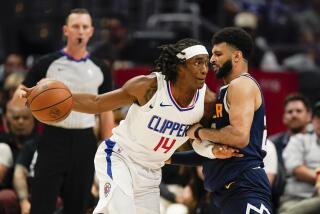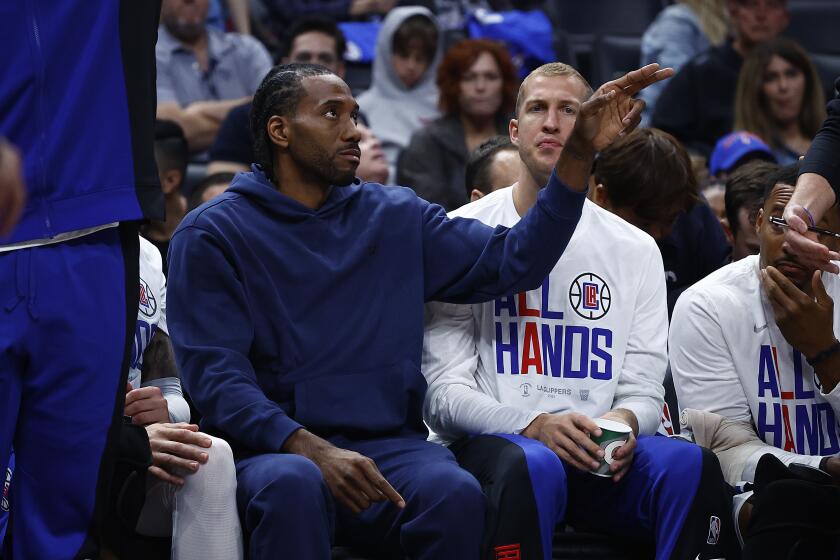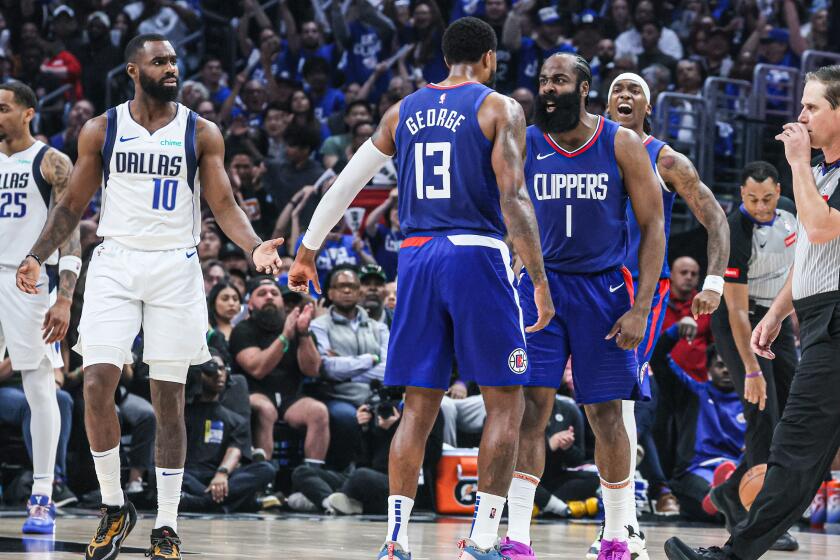Natalie Nakase seeks to climb from Clippers’ video room to NBA coach

Natalie Nakase knew there would be doubters.
Her basketball dreams have been shrouded in skepticism since her mom asked her as a child when she might be done with the sport so she could start focusing on becoming a Laker Girl.
As a speck of a point guard who barely cleared 5 feet in high school, she was called “Nat the Gnat.”
The disbelievers wouldn’t disperse even after she became a three-year starter at UCLA and played professionally for three years until torn knee cartilage forced her to pursue coaching.
Now, as the Clippers’ assistant video coordinator, the naysaying is harder to take. She answered her phone in July and heard her father’s voice.
“What is this I’m reading?” asked Gary Nakase, referring to a newspaper article. “Now, all of a sudden you want to be an NBA head coach? This is what you’re publicly saying?”
Natalie was stunned she had neglected to tell her father of her hopes because they shared everything. She was also shocked at what she was hearing.
“Not in this lifetime,” her father continued, she recalled.
“You want to bet a million dollars?” shot back Natalie, 34.
Nakase’s feisty defiance is one reason those in NBA circles refuse to question her desire to make the same climb from the video room to the head coach’s office made by Miami’s Erik Spoelstra, Indiana’s Frank Vogel and former Lakers Coach Mike Brown.
So what if she happens to be a tiny Japanese American woman? What does that have to do with getting a team to defend the pick and roll?
“I would probably tell her to ask the question, ‘Why not?’ To start with that,” Spoelstra said when asked what advice he would give Nakase. “Certainly, she’s off to a very good start. She’s learning the game. She’s changing people’s perspectives about who can be in what position.
“Just keep on working the game and being true to the game and hope that eventually the game will be true to you.”
She could almost pass for a ball girl, standing 5 feet 1 3/4 in athletic shorts and a T-shirt underneath the basket inside Staples Center as Blake Griffin takes jump shot after jump shot before a recent game.
She chases good and bad shots with equal fervor, throwing crisp chest passes to the Clippers star. Fetching rebounds is only the smallest of Nakase’s duties. She often logs 17-hour days compiling video edits of opponents’ games and spends home games inside a room crammed with computers and flatscreen televisions deep inside Staples Center.
The first sign that all the drudgery might be worth it came this summer when Clippers Coach Doc Rivers summoned her into his office. “I’m just like, ‘Oh, man, what did I do?’ ” Nakase recalled.
Rivers looked directly at her and asked: Did she want to help coach the Clippers’ summer league team?
Of course she did. But her euphoria subsided slightly when she was assigned to put the team through a transition drill and realized she wasn’t fully prepared.
Clippers assistant coach Armond Hill met her at the practice court to help her rehearse her presentation. She stumbled over her words and took much longer than the 30 seconds normally allotted for drills.
“She was concerned about projecting her voice to players,” Hill said, “and I tried to explain to her that when she does a drill, a coach is not going to give you two minutes.”
Nakase returned to the practice facility that night and recorded her voice so she could hear whether it was loud enough and whether she was cluttering her speech with unnecessary words. She also studied extra plays to run just in case Brendan O’Connor, the Clippers’ head summer league coach, asked for them.
“I wanted to make sure my first opportunity was going to be a big statement,” she said.
After Nakase directed players through the drill, her voice strong, her delivery concise, Hill approached her to deliver his verdict.
“Great job,” he said.
Nakase grew up wanting to play basketball, not coach it. Actually, there were many days she didn’t want to play it either.
“I wanted to be with all my friends,” she said. “I wanted to go to sleepovers.”
Her father said sleepovers were not allowed, even at the Nakase home. They might ruin her preparation for working out the next day.
From the time she was 5, Nakase’s life revolved around basketball leagues and camps. Natalie and her two older sisters, Nicola and Norrie,had their own personal trainer and coach who helped them practice year-round. Vacations were essentially out-of-town basketball tournaments.
Sometimes Natalie would pretend to wake up too tired to work out. Her father wouldn’t hear of it.
“He said, ‘Get your … in the car and let’s go to practice,’ ” she recalled.
Nakase’s coaching instincts were on display from a young age. She was often the player her teammates at Marina High in Huntington Beach would approach with their problems. At UCLA, she once made a suggestion to then-Coach Kathy Olivier about switching defenses after a Texas player repeatedly scored by penetrating.
The change worked and the Bruins won.
“Everyone said growing up, ‘You’re going to be a really good coach,’ ” Nakase said. “And I was like, ‘I don’t want to be a good coach; I just really want to be a really good player.’ ”
She was that as well, spending two seasons as the first Asian American in the now-defunct National Women’s Basketball League before joining a professional team in Germany for one season. Then came the knee injury that changed her career.
Deciding she did not want to undergo surgery to prolong her playing career, Nakase coached the Wolfenbuttel Wildcats, a professional women’s team in Germany, for two years, before visiting a friend who was playing in Japan. He introduced her to Bob Hill, the former NBA coach who was then in charge of the Tokyo Apache, a professional men’s team.
Hill invited Nakase to attend a team practice, with one caveat. “You can watch,” he told her, “just stay off the court.”
Unswayed, she kept coming back every day, always showing up early, until Hill asked her to compile a scouting report. He was impressed and made her part of his staff.
Hill said his players respected Nakase, even more so when she beat them in shooting competitions after practice. “That,” he said, “was funny.”
When the Apache folded, Hill convinced the coach of another team, the Saitama Broncos, to hire her as an assistant. She was quickly elevated to run the team when her boss was fired 12 games into the season, becoming the first female head coach in Japan’s top-level pro league.
Nakase was a one-woman operation, compiling scouting reports, watching video and running practices. And she came away from her one season with some regrets beyond a losing record.
“I wish I was more open to my players,” she said. “I was like, ‘OK, you’re going to do your job, you’re going to do that, whatever, boom, I’ll see you at practice.’ Watching Doc, you have to open yourself too; you have to open your heart and open your life to them as well and show that you care about them.”
Nakase returned to Southern California in the summer of 2012 after being unable to convince executives from the Broncos to let her have a say in the roster.
A friend invited her to attend a coaches clinic that September, which excited Nakase until she discovered it was a youth coaches clinic.
Fortunately for her, the man running the clinic was Dave Severns, the Clippers’ assistant player skills coach. Severns enlisted Nakase as his demonstrator because of her ballhandling skills and later granted her request to watch the Clippers practice so she could learn about the workout routines of Griffin and Chris Paul.
Like she had in Japan, Nakase kept showing up, day after day, until the Clippers asked her what she did since she obviously had so much free time. That’s when she told them she wanted to work in video because it was the perfect entry-level NBA job.
At practice one day, then-Coach Vinny Del Negro snatched her notepad to see what she was writing. “Luckily,” Nakase said, “I was taking really good notes.”
Del Negro hired Nakase as an unpaid video intern and Rivers retained her when he succeeded Del Negro in the summer of 2013. Before this season, Rivers promoted her to her current title and gave her a salary.
Nakase eagerly shuffles from spot to spot on the Clippers’ practice court, playing defense, setting screens or encouraging DeAndre Jordan while he works on his free throws.
“We all respect her on this team,” Jordan said. “She has great insight and we value her opinions because she does some of our scouts, so she definitely knows her stuff.”
Nakase has increased her insight into casual coaches’ banter by sitting in on pre-practice meetings with Rivers and his assistants, staying mindful of Bob Hill’s advice to always prepare for the next opportunity.
“She’s very honest,” Rivers said. “She’s not worried about telling a guy that outweighs her by 200 pounds and makes whatever amount more than her the truth, and I think that’s a great quality.”
Nakase insists she’s not trying to break racial or gender barriers like San Antonio’s Becky Hammon, the first female NBA assistant coach; she just wants to be a quality coach.
“I really feel it’s whether I’m qualified or not,” Nakase said.
Sometimes showing you belong takes standing up to your own father when he doesn’t think your dreams are realistic.
“I started to realize my No. 1 fan, my No. 1 everything, my best friend didn’t believe in my goal, but I had to be OK with that and turn it into motivation,” Nakase said. “Now I’ve realized that you have to believe in yourself; that’s it, that’s the only person. You’re going to have people who are going to doubt you.”
Twitter: @latbbolch
More Clippers news:
Clippers still motivated by playoff collapse against Thunder
Chris Paul keeps promise to take fan to Cleveland game
More to Read
Get our high school sports newsletter
Prep Rally is devoted to the SoCal high school sports experience, bringing you scores, stories and a behind-the-scenes look at what makes prep sports so popular.
You may occasionally receive promotional content from the Los Angeles Times.







